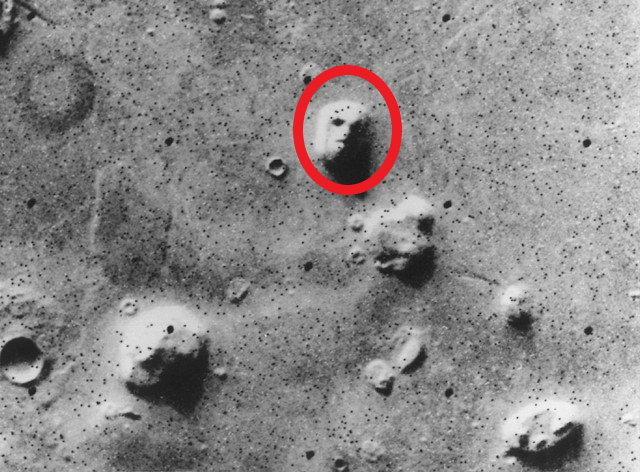In 1976, the American Viking 1 Orbiter spotted something very peculiar on the surface of Mars. There among the many lumps and bumps of the Red Planet’s surface was a formation that “resembles a human head,” as ESA reports NASA said in a July 31, 1976 press release.
ADVERTISEMENT GO AD FREE
In case your pareidolia senses aren’t tingling, we’ve gone ahead and highlighted the “face on Mars” in the version below. It’s not the only face on Mars ever caught on camera, but it’s perhaps the most famous. So, what is it?
The formation was photographed in a region of the Red Planet known as Cydonia. Before you Muse fans get too excited thinking we’ve finally found a knight, the famous face on Mars is, in truth, just a very cool trick of the light. The optical illusion was all down to timing, with the illumination angle of the Sun being just right to cast shadows from blips on the formation’s surface. Mix that all together in one still image and you have yourself something that “resembles a human head,” just like NASA said.

Hello beautiful.
Martian civilizations
We humans, however, weren’t willing to let the dream die just yet, convinced some extraterrestrial had become a stamp on the surface of Mars. Speculation about the face ran riot, with a vocal few convinced that it was proof of a Martian civilization.
The most enthusiastic conspiracy theorists figured that the other features in the Cydonia region were the remains of pyramids and cities these Martians had built, marking a history-altering discovery that those pesky space agencies didn’t want us to know about. After all, why would you dedicate your time, money, and life to space exploration if you were just going to go and spill all your secrets to us terrestrial folk, eh?
Some still maintain the alleged coverup, but human technologies have returned to this region of Cydonia on multiple occasions, proving time and time again that the face on Mars is just a fancy hill. Though, we admit, that doesn’t sound anywhere near as sexy.
ADVERTISEMENT GO AD FREE
Some remarkably detailed images of this area were snapped in 2006 when the atmospheric dust and haze finally cleared enough to get a good shot. The images weren’t just fascinating for lovers of space mythology, but also for the fact they gave an incredible close-up of an area of Mars that planetary geologists are very interested in. Why? Because the Mars face is so much more than a face.
What is “the Mars face”?
The little hill seen in the Mars face photo is what’s known as a mesa, features that are typically wide but not very tall with a flat top. This revelation was confirmed in images snapped in 2007 using the High Resolution Imaging Science Experiment (HiRISE) camera on the Mars Reconnaissance Orbiter.

The eroded mesa as seen by HiRISE compared to what the Viking 1 Orbiter saw in the bottom right corner.
As the image quality improved, the Mars face faded away, but in its place scientists discovered a time capsule of the Red Planet’s history. Mesas are though to form as the result of sedimentary layers being eroded over a long period of time, and that erosion can involve wind, water, or ice.
The Red Planet had a wet past and is thought to have had an ocean covering the northern hemisphere (where Cydonia sits), as new data from the Chinese rover Zhurong recently suggested. The mesas in Cydonia are said to be rich in ice, and a recent study of mesas in the Chryse Planitia region showed that they contain clay minerals, which only form when water interacts with rock for a very long time.
ADVERTISEMENT GO AD FREE
“This research shows us that Mars’ climate was dramatically different in the distant past,” scientist at the Natural History Museum Dr Joe McNeil said in a statement. “The mounds in Chryse Planitia are rich in clay minerals, meaning liquid water must have been present at the surface in large quantities nearly four billion years ago.”
“As a result, the mounds preserve a near-complete history of water in this region within accessible, continuous rocky outcrops. The European Space Agency’s upcoming Rosalind Franklin rover will explore nearby, and could allow us to answer whether Mars ever had an ocean, and if it did, whether life could have existed there.”
The face itself has some merit, too. This particular mesa is surrounded by an early debris apron from landslides, and its surface morphologies may be the markers of how and where it fell apart. So don’t pooh-pooh the “human head” on Mars entirely. The actual nose, mouth, and eyes might be a superficial illusion, but what’s beneath it could reveal a planet very different to the lifeless red orb we see today.
Source Link: What We Know About “The Face On Mars” First Seen In 1976